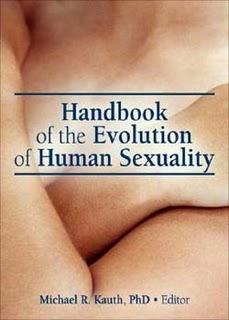Handbook of the Evolution of Human Sexuality

The style and content in a sentence: Professional enough for an academic, but thought provoking for the general public. If you’re reading this with thoughts that the “Evolution” part of this title might limit the diversity of coverage of “Human Sexuality,” read on. Most of what we might have learned about evolution and sex on public television, in high school biology, health class and even in psychology 101 leaves everything other than heterosexual, reproductive, cave-man sex in the archeological dust. Handbook of the Evolution of Human Sexuality balances out former schooling in an extremely intelligent way.
The chapters are peer reviewed articles, also published as part of the Journal of Psychology and Human Sexuality. Chapters include The Evolution of Sexual Pleasure, How Ecology, Genes, Fertility and Fashion Influence Mating Strategies, Sexual Strategies Across Sexual Orientations and several chapters on same-sex orientation. The authors, mostly US & UK leaders in psychology, include an independent researcher, a clinical psychologist and an archeologist well read in sex, art and ethno-botany.
Artifacts in the form of art and traditions are provided and sociological explanations for sexual orientations and behaviors throughout human evolutionary history are proposed. Early images of women are interpreted as images of power rather than simply as sex-objects. Male-male sexual interactions are explained as adaptive alliances rather than subversions of society. Cross dressing, transgender and trans-sex are given a history much older than this century in places other than metro-sexual.
The articles are written to stand intellectual scrutiny, but the average person could probably read parts as an amendment to traditional text-book biology. Fascinating observations about same-sex interactions in social species are described. Historical evidence of accidental and intentional hormone alteration by humans with natural agents - such as consumption of hormones in mare’s urine (think 'premarin'), estrogenic plants and plants used for birth control - make the handbook memorable, quotable and eye opening to a history of human use of drugs affecting sex, often considered to be new or unnatural.
Sociologists, biology nerds, LGBTQ allies, alternative academics and anyone who’s spent lonely evenings reading about the science and history of sex could enjoy this book. Evolutionary psychologists ought to keep it as a professional reference. Though written to expand a discipline’s understanding of human behavior, this book appeals to curiosity about diversity in sexuality and individual choice.